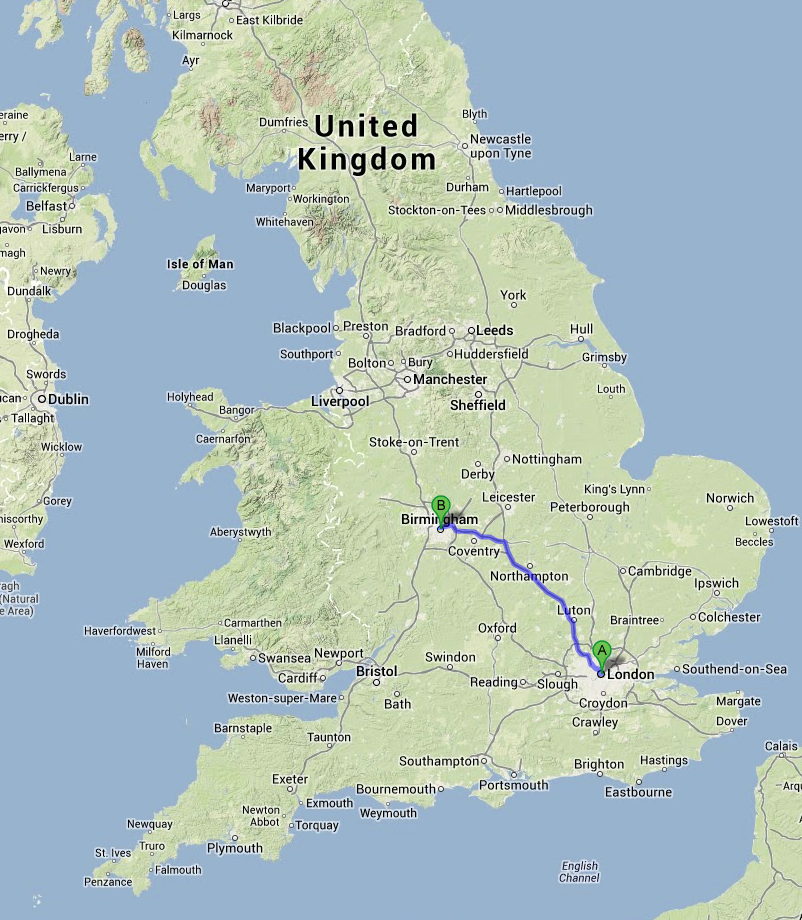Fly me to the moon...or maybe just take a train to Birmingham instead
The UK government has been planning a new high-speed rail network known as HS2, the first phase of which will connect London to Birmingham (the UK's second city).

I was shocked to discover that the planned timetable for this initial phase spans nine years (2017–2026). The surprise is because the distance for the London to Birmingham route is only 119 miles. Less surprising — but sadly more predictable — is the recent news that the planned costs for the first part of this project are now projected to be 30% above the initial budget (up to £21.4 billion, ~$32.1 US billion).
This seems a lot of money to connect two cities that are not so far apart. I'm sure that this budget has to cover lots of other things besides the actual construction (e.g. purchasing land). But even setting the cost aside, will it really take almost a decade to construct the line? This is the best-case scenario of course, and pessimists among us no doubt imagine that there will almost certainly be delays (assuming the project is not derailed — metaphorically, not literally — by opposition campaigns).
We are not talking about building a railway line across mountainous terrain or having to circumvent huge lakes. However, any route built in the UK does have to face the twin forces of nature that are leaves on the line and the wrong type of snow.
How did things get so bad? After all, we are the country that introduced the first public passenger railway (1825), the world's first intercity railway (1830), and we also have the world's oldest continuously working public railway (since 1758). We used to be good at building railways!
So just to summarize the costs, timetable, and distance of this rail route:
- $32.1 billion
- 9 years
- 119 miles
If we convert this into a cost-per-year-per-mile, we get a figure of $29,971,989. How does this compare to some other public transportation projects? Well, the new Eastern span of the San Francisco-Oakland Bay Bridge will hopefully open this year. It is running over time and budget, and still keeps running into problems. How does this project compare to the UK's HS2 line?
- $6.3 billion
- 11 years
- 2.2 miles
Cost-per-year-per-mile: $260,330,579 (almost an order of magnitude worse than HS2).
One final comparison. Between 1969 and 1972, the Apollo program put 12 men on the moon. This is, as you might imagine, much harder to work out the total cost of this massive project. There are some estimates that try to allow for inflation, and these put the final bill of the Apollo program between $153 and $422 billion. Let's go with the upper limit of this estimate. That gives us:
- $422 billion
- 13 years
- 239,000 miles
Cost-per-year-per-mile: $135,822 (a bargain!).
Of course these very fickle calculations make no effort to factor in how many people make use of these routes. The Apollo missions only took a grand total of 24 people to the moon (and of course not all of them got there), whereas the Bay Bridge carries 280,000 vehicles a day. However, I still can't get past the fact — and again this assumes that the project won't overrun at all — that the 1st phase of HS2 will see an average of just over 1 mile of the route completed per month of the nine year construction phase. British Rail — the former nationalized rail company that ran the UK's railways — once had a series of TV adverts that ended with the proclamation "We're getting there". A modern day update to this slogan might be "We're getting there...slowly".